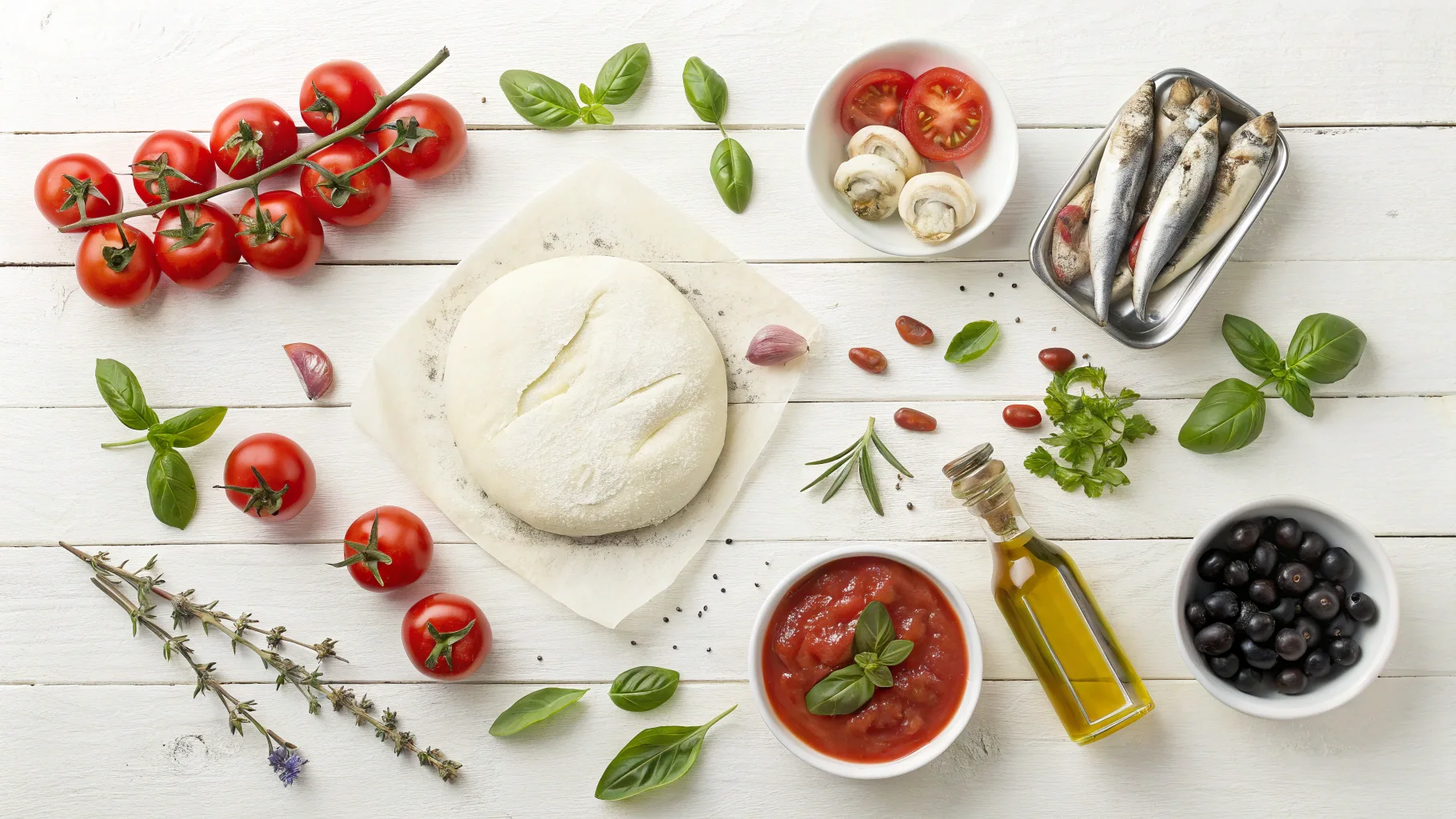Picture yourself standing before a wood-fired oven, watching bubbles form on golden dough while aromatic herbs mingle with the scent of melted cheese. Your eyes catch sight of those distinctive silvery strips nestled atop your pizza – anchovies. Suddenly, doubt creeps in. Are you making a wise nutritional choice, or sabotaging your wellness goals?
This internal debate happens more often than you might imagine. The polarizing nature of anchovies leaves many pizza enthusiasts questioning whether this Mediterranean delicacy deserves a spot in their healthy eating plan. Today, we’ll uncover the nutritional reality behind anchovy pizza and explore practical strategies to maximize its health benefits.
Is Anchovy Pizza Healthy? Breaking Down the Nutritional Profile
The Nutritional Powerhouse Hidden in Anchovies
Your concerns about anchovy pizza might dissolve once you discover what these tiny fish bring to your plate. Unlike many pizza toppings that offer empty calories, anchovies pack extraordinary nutritional density into their small frames.
Omega-3 Fatty Acids: Your Heart’s Best Friend
Each serving of anchovies delivers approximately 1,165 milligrams of omega-3 fatty acids – specifically EPA and DHA, the forms your body utilizes most effectively. These essential fats support cardiovascular health by reducing inflammation, lowering blood pressure, and improving cholesterol profiles. When compared to salmon or tuna, anchovies actually contain higher concentrations of these beneficial compounds per serving.
Complete Protein Profile
Two ounces of anchovies provide roughly 8.2 grams of complete protein, containing all nine essential amino acids your body cannot produce independently. This protein content surpasses most traditional pizza toppings, supporting muscle maintenance and promoting satiety that helps control appetite throughout your day.
Vitamin and Mineral Treasury
Anchovies excel as sources of vitamin B12, delivering nearly 85% of your daily requirement in a single serving. This crucial vitamin supports nerve function and red blood cell formation. Additionally, you’ll receive substantial amounts of niacin for energy metabolism, selenium for antioxidant protection, and calcium for bone health.
The Pizza Base Reality Check
While anchovies shine nutritionally, your pizza’s foundation significantly impacts its overall health value. Traditional pizza crusts made from refined white flour contribute primarily empty calories and blood sugar spikes.
Crust Considerations
The type of crust you choose dramatically affects your pizza’s nutritional profile:
- White flour crust: High in refined carbohydrates, low in fiber
- Whole wheat crust: Increased fiber content, B vitamins, and minerals
- Cauliflower crust: Lower carbohydrates, additional vegetable servings
Cheese and Sauce Analysis
Standard mozzarella cheese adds protein and calcium but also contributes saturated fat and sodium. Pizza sauce, while providing lycopene from tomatoes, often contains added sugars and significant sodium levels. Balancing these components becomes crucial for maintaining your pizza’s health credentials.
Sodium Concerns: The Salty Truth About Anchovy Pizza
The elephant in the room regarding anchovy pizza health involves its substantial sodium content. Two ounces of anchovies contain approximately 1,040 milligrams of sodium – nearly half your recommended daily intake.
However, this concern requires perspective. Processed meats like pepperoni or sausage, while containing less sodium per serving, often appear in larger quantities on pizza. Additionally, anchovies’ intense flavor means you typically use smaller amounts while achieving satisfying taste.
Managing Sodium Impact
You can minimize sodium concerns through strategic approaches:
- Rinse anchovies briefly before use to remove excess salt
- Balance with potassium-rich vegetables like tomatoes and spinach
- Increase water intake when enjoying anchovy pizza
- Pair with low-sodium sides and meals throughout your day
How to Make Anchovy Pizza Healthier: 7 Game-Changing Strategies
Smart Crust Swaps for Better Nutrition
Whole Grain and Alternative Crusts
Transforming your pizza’s foundation creates the most significant health improvement opportunity. Whole grain crusts provide sustained energy release, preventing the blood sugar rollercoaster associated with refined flour alternatives.
Benefits of Whole Wheat Pizza Dough:
- Triple the fiber content of white flour versions
- Enhanced B vitamin profile supporting energy metabolism
- Better appetite control through improved satiety
- Slower digestion promoting stable blood sugar levels
Cauliflower Crust Advantages:
- Reduces carbohydrate content by approximately 75%
- Adds vegetable servings to your meal
- Provides natural gluten-free option
- Increases overall nutrient density
Quick Healthy Pizza Crust Recipe

| Ingredient | Amount | Benefits |
|---|---|---|
| Whole wheat flour | 2 cups | High fiber, B vitamins |
| Greek yogurt | 1 cup | Protein, probiotics |
| Baking powder | 1 tsp | Leavening agent |
| Salt | 1/2 tsp | Flavor enhancement |
| Olive oil | 1 tbsp | Healthy fats |
Mix ingredients until dough forms, roll thin, and bake at 450°F for 10-12 minutes before adding toppings.
Cheese Modifications That Don’t Sacrifice Flavor
Lighter Cheese Options
Reducing cheese quantity while maintaining satisfaction requires strategic substitutions. Part-skim mozzarella reduces saturated fat content by 25% compared to whole milk versions while preserving taste and texture.
Mixing regular cheese with ricotta creates creamy texture using less total cheese. This substitution adds protein while reducing overall fat content. Nutritional yeast sprinkled over your pizza provides cheesy flavor with added B vitamins and protein.
Maximizing Anchovy Benefits While Minimizing Drawbacks
Portion Control Mastery
Understanding appropriate anchovy portions ensures you receive nutritional benefits without excessive sodium intake. One to two ounces per pizza typically provides optimal flavor while keeping sodium levels manageable.
Visual guides help maintain appropriate portions:
- 8-10 anchovy fillets equal approximately one ounce
- Distribute evenly across pizza surface for consistent flavor
- Combine with other umami-rich ingredients to enhance satisfaction
Quality Anchovy Selection
Fresh anchovies, when available, contain less sodium than their canned counterparts. However, high-quality canned anchovies packed in olive oil provide convenience while maintaining nutritional benefits. Look for sustainably sourced options supporting both your health and environmental responsibility.
Vegetable Power-Ups for Your Anchovy Pizza
Mediterranean Vegetable Combinations
Strategic vegetable additions transform your anchovy pizza into a nutrient-dense meal supporting overall health goals.
Healthy Vegetable Toppings:
- Roasted bell peppers: Vitamin C powerhouses supporting immune function
- Cherry tomatoes: Lycopene content promoting heart health
- Red onions: Antioxidant compounds reducing inflammation
- Fresh basil: Anti-inflammatory properties and aromatic appeal
- Arugula: Iron and folate supporting energy production
- Kalamata olives: Healthy monounsaturated fats complementing anchovies
Preparation Methods That Preserve Nutrients
Timing vegetable additions preserves maximum nutritional value. Add heartier vegetables like peppers and onions during initial cooking, while delicate greens like arugula benefit from post-baking addition. Light roasting vegetables before pizza assembly concentrates flavors while maintaining nutrient integrity.
Healthy Anchovy Pizza Recipes for Every Dietary Need
Classic Mediterranean Anchovy Pizza (Healthified)
This recipe balances traditional flavors with modern nutritional awareness, creating a pizza that satisfies both taste and health requirements.
Complete Nutritional Breakdown:
| Component | Ingredient | Amount | Calories | Key Nutrients |
|---|---|---|---|---|
| Crust | Whole wheat flour | 2 cups | 760 | Fiber, B vitamins |
| Sauce | Crushed tomatoes | 1 cup | 35 | Lycopene, vitamin C |
| Cheese | Part-skim mozzarella | 6 oz | 480 | Protein, calcium |
| Protein | Anchovy fillets | 2 oz | 60 | Omega-3, protein |
| Vegetables | Mixed vegetables | 2 cups | 50 | Various vitamins |
Total per pizza: 1,385 calories (serves 6-8)
Step-by-Step Preparation
- Dough preparation: Combine whole wheat flour with Greek yogurt and seasonings, creating protein-enhanced base
- Sauce development: Blend crushed tomatoes with herbs, avoiding added sugars
- Strategic assembly: Layer ingredients thoughtfully for even cooking
- Optimal baking: High heat (475°F) for 12-15 minutes creates crispy crust while preserving toppings
Low-Carb Anchovy Pizza Alternative
For those managing carbohydrate intake, cauliflower crust provides satisfying alternative without compromising flavor or nutrition.
Nutritional Comparison:
| Pizza Type | Calories per slice | Carbs (g) | Protein (g) | Fat (g) |
|---|---|---|---|---|
| Traditional | 285 | 36 | 12 | 10 |
| Whole wheat | 265 | 32 | 14 | 9 |
| Cauliflower | 195 | 8 | 15 | 12 |
When Anchovy Pizza Fits Into a Healthy Diet
Meal Planning Integration Strategies
Frequency Guidelines
Including anchovy pizza once or twice weekly aligns with healthy eating patterns when balanced with lighter meals. This frequency allows you to enjoy the dish’s benefits while maintaining dietary variety and nutritional balance.
Consider anchovy pizza as your omega-3 source for the week, complementing other lean proteins and plant-based meals. This approach ensures diverse nutrient intake while satisfying pizza cravings responsibly.
Pairing with Healthy Sides
Complementary Foods:
- Mixed green salad with olive oil dressing provides additional nutrients
- Roasted Mediterranean vegetables extend the meal’s vegetable content
- Fresh fruit dessert adds fiber and natural sweetness
- Herbal tea or lemon water supports hydration and digestion
Fitness Goals and Pizza Consumption
Pre and Post-Workout Considerations
Anchovy pizza’s carbohydrate and protein combination makes it suitable for post-workout recovery when timed appropriately. The protein supports muscle repair while carbohydrates replenish glycogen stores depleted during exercise.
For athletes or active individuals, consuming anchovy pizza within two hours post-workout optimizes recovery benefits. The omega-3 fatty acids additionally support exercise-induced inflammation reduction.
Comparing Anchovy Pizza to Other Popular Options
Nutritional Showdown: Anchovy vs. Common Toppings
Understanding how anchovies stack against popular alternatives helps you make informed topping decisions.
Comprehensive Comparison:
| Topping | Calories (per 2oz) | Protein (g) | Sodium (mg) | Healthy Fats | Special Benefits |
|---|---|---|---|---|---|
| Anchovies | 60 | 8.2 | 1040 | Omega-3 | Heart health |
| Pepperoni | 230 | 10 | 520 | Saturated | High calories |
| Chicken | 140 | 26 | 45 | Minimal | Lean protein |
| Vegetables | 25 | 2 | 10 | None | Fiber, vitamins |
While anchovies contain more sodium than alternatives, their unique omega-3 profile and lower calorie density provide distinct advantages supporting cardiovascular health and weight management.
FAQ: Is Anchovy Pizza Healthy?
Is anchovy pizza healthy for weight loss? Anchovy pizza supports weight loss goals when prepared with whole grain crusts, controlled cheese portions, and abundant vegetables. The protein and healthy fats promote satiety, potentially reducing overall calorie consumption.
How often can I eat anchovy pizza while maintaining a healthy diet? Enjoying anchovy pizza 1-2 times weekly fits comfortably within balanced eating patterns, especially when paired with lighter daily meals and regular physical activity.
Is anchovy pizza healthy compared to pepperoni pizza? Anchovy pizza generally surpasses pepperoni pizza nutritionally due to omega-3 fatty acids, lower calories, and beneficial nutrients, despite higher sodium content.
Can people with high blood pressure eat anchovy pizza? Individuals managing high blood pressure should consume anchovy pizza moderately due to sodium content. Choosing low-sodium cheese and sauce while increasing water intake helps mitigate concerns.
What makes anchovy pizza healthy compared to other seafood pizzas? Anchovy pizza excels due to exceptional omega-3 content, complete protein profile, and high vitamin B12 levels, making it among the most nutritionally dense seafood pizza options.
Your Next Steps Toward Healthier Pizza Nights
The question “Is anchovy pizza healthy?” reveals a nuanced answer: absolutely, when approached thoughtfully. These tiny Mediterranean fish transform ordinary pizza into a nutrient-dense meal supporting your wellness goals through exceptional omega-3 content, complete proteins, and essential vitamins.
Success lies in mindful preparation choices. Selecting whole grain crusts, controlling cheese portions, and loading vegetables creates a balanced meal that satisfies both nutritional needs and taste preferences. The occasional anchovy pizza can absolutely coexist with your healthy lifestyle when prepared consciously.
Ready to revolutionize your pizza night? Start with one small change – swap your regular crust for whole wheat next time you order or make anchovy pizza. Notice how this single modification affects your satisfaction and energy levels. Share your healthy anchovy pizza creations in the comments below, and inspire others to discover this Mediterranean treasure’s nutritional potential.
Your journey toward healthier eating doesn’t require sacrificing beloved foods – it simply demands smarter preparation. Anchovy pizza proves that with the right approach, indulgence and nutrition can coexist beautifully on your plate.

